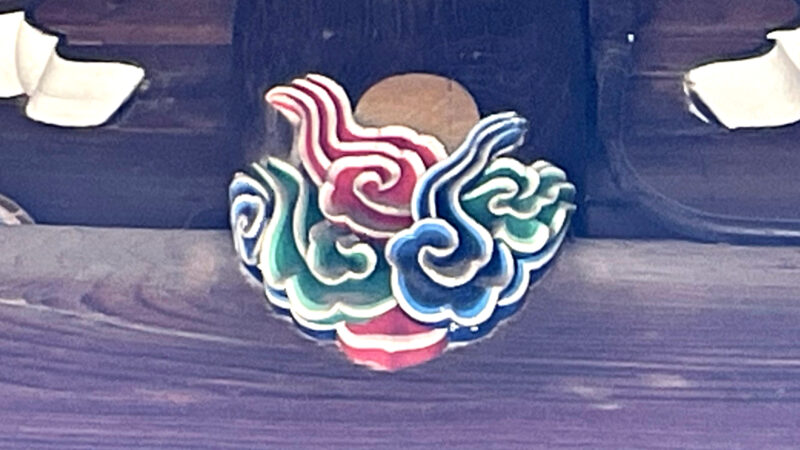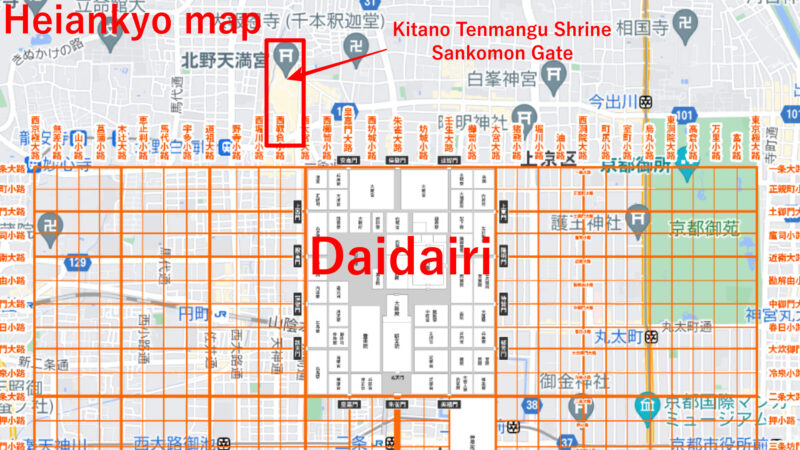The middle gate in front of the main hall of Kitano Tenmangu is called Sankomon(
three gates of light), and is an important cultural property that is said to have been built by Toyotomi Hideyoshi in 1607.
The Sankomon Gate, which has a plaque that says “Tenmangu Shrine” written by Emperor Gosai, is also called “Sankomon Gate without Stars” and is considered one of the Seven Wonders of Kitano Tenmangu Shrine.
The reason why it is called ‘Hoshikatsu no Sankomon’ is that the ‘Sun’ and ‘Moon’ are carved, but there is no ‘Star’ carved.
However, from the approach to the south side, you can see the North Star that shines right above the gate, so when you put these together, the three lights of the sun, moon, and stars are completed.
Sculptures of the “sun” and “moon” on the north and south sides of the beams hanging in the middle of the ceiling of Sankomon
sun sculpture

moon sculpture

Sankomon’s “three lights” is derived from “seishin-worship,” which worships the sun, moon, and stars as special things.
In the case of this gate, the carvings of the sun and moon and the natural celestial body, the North Star, are superimposed to complete the work.
Night view of Sankomon Gate
I looked up at the night sky from the southern approach on a clear day just before the gates closed in order to catch a glimpse of the Polar Star shining above the Sankomon Gate, but the light from the lanterns lighting the approach was too strong, so I couldn’t see the Polar Star.
Unfortunately, I wasn’t able to see the North Star shining directly above Sankomon, but the lanterns that light up the approach and the Sankomon, in the silence of no visitors, make me feel as if I’ve entered another world.
Normally, the gates close at 5:00 pm, but on the 25th of every month, the gates are open until 7:00 pm, so if you want to see this scenery, please visit on the evening of the 25th.( The 25th of every month is the fair day of Kitano Tenmangu.)
Why wasn’t the Sankomon engraved with stars?
When looking up at Sankomon from the south approach, the North Star shines brightly, so no stars were carved. This is a great way of thinking about harmony with nature.
However, there is also a theory that stars were also carved into the gate, and others say that only the sun and the moon were worshiped in the first place.
It is generally believed that during the Heian period, when the emperor worshiped Kitano Tenmangu Shrine in the north direction from the Daidairi, he did not carve a star because the North Star was shining directly above the Sankomon Gate.
The reason for this is that the location of the Daidairi during the Heian-Kyoto period is not directly south of Kitano Tenmangu Shrine, but rather south-southeast, so even if you look at the Sankomon Gate from the grounds of the Daidairi, it will not overlap with the North Star.

Daidairi is the Imperial Palace of Heiankyo (the Emperor’s palace and the government offices surrounding it), and is also called Heiangu.
The belief in the sun and the moon is based on the theory that “Amaterasu Omikami”, which appears in Japanese mythology, was worshiped as the sun, and “Tsukuyomi” as the moon.
According to the Kojiki and Nihonshoki, Amaterasu Omikami is the ‘sun goddess’ and Tsukiyomi no Mikoto is the ‘moon goddess’ of the three noble gods born from the purification ceremony (water bathing) of Izanagi-no-Mikoto, the creator of Japan.
Summary
This time, I tried to consider Sankomon (Starless Sankomon), which is considered to be one of the seven wonders of Kitano Tenmangu.
There are various theories as to why it is so mysterious, but it seems unreasonable to believe that if you look at the Sankomon Gate from the Daidairi of Heiankyo, you can see the North Star directly above.
However, there is definitely a North Star in the direction of Sankomon from the south approach to the main shrine. And it must be true that in the days of torches and candles, the North Star could be seen shining right above the Sankomon Gate from the approach.

